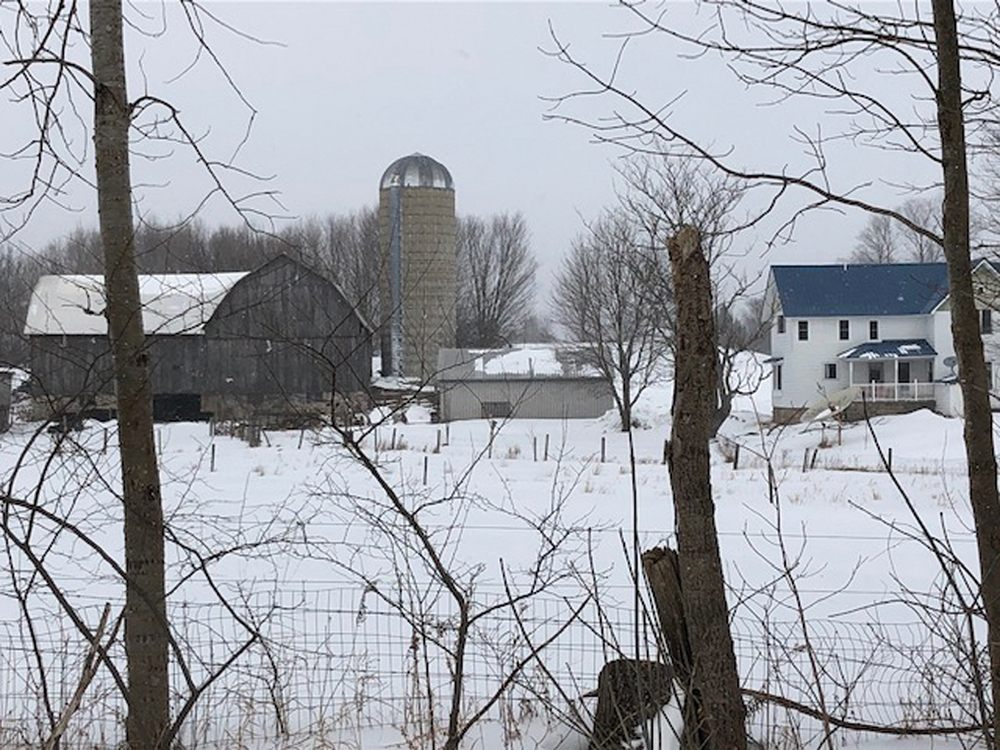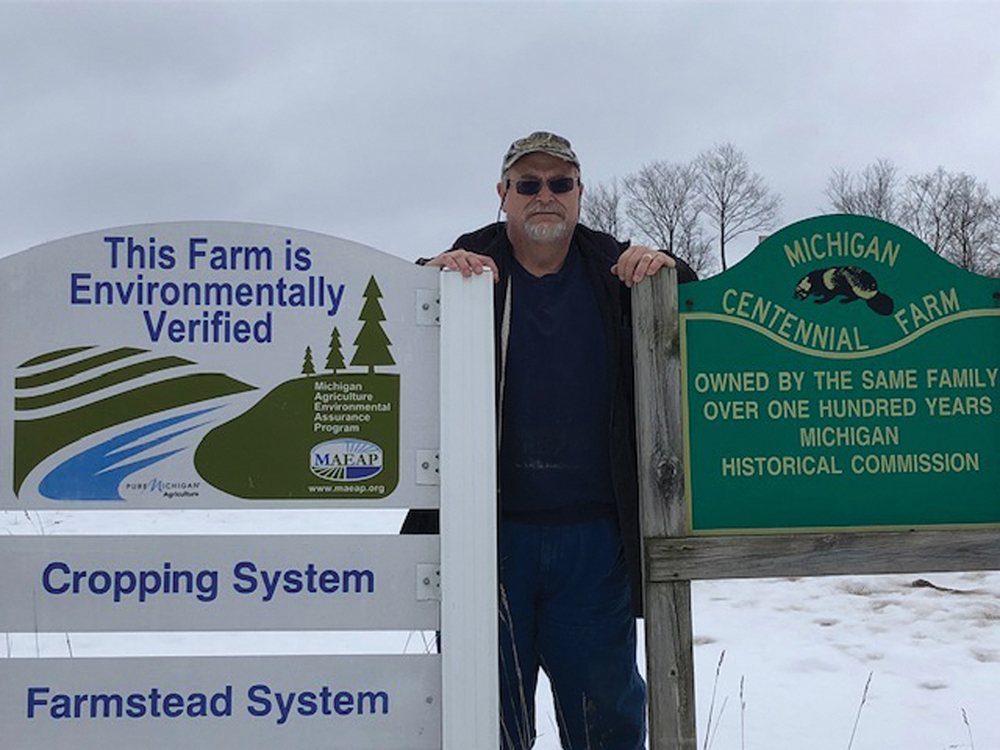All in the family, for more than 100 years
By Jana Goldman
Current Contributor
In jeans, a crewneck sweatshirt, a flannel overcoat, and a camouflage baseball cap, a farmer walks the snow-covered path from his blue truck to an old, weathered barn. Randy Rice (53) can trace his roots back to Ireland. So can the livestock he raises. On land once owned by one of two brothers named Bellows, the Rice family first set down farming roots here in Benzie County at the turn of the 20th century.
Rice’s human roots likely started in Poyntzpass, a small village on the border of two counties—Armagh and Down—in what is now Northern Ireland. Thomas Rice and his son, James, left Derry aboard the St. Andrews, landing in Quebec City. Matthew Rice—James’s son, and Randy’s great-grandfather—was born about 1870.
The Rices left Quebec and settled in Ontario. When they left Ontario, they brought some shorthorn cattle with them to Michigan. Randy’s grandfather, Robert, switched from shorthorn to Angus in the late 1940s/early 1950s. Subsequently, the herd was all Angus until Randy’s father, Roy, retired from farming in 1995 and sold the herd.
Randy Rice started over completely; for a time, he tried raising a smaller breed, Dexters, also from his ancestral Ireland, around the same time that his family left Europe—stemming from the Irish dairy breed Kerry, the animals, which were named after a Mr. Dexter who promoted them during the mid-1800s, were bred for a smaller size and improved beef. But Randy Rice soon realized that they were too small. So, he crossbred them with black and red Angus to create the herd he now raises.
“It’s really important to keep connected to your heritage and help pass the land on to future generations, so they can use it when they want to,” Rice says.
Historical
With its blue silo and white farmhouse, the Rice Centennial Farm is easily seen from US-31 at the intersection with Mick Road. What a visitor also notices are two signs just to the right of the farm entrance: one indicates that this farm meets the standards for the Michigan Agricultural Environmental Assurance Program (MAEAP); the other announces that this is a Michigan Centennial Farm.
For more than a century, travelers heading south toward Manistee on the road now known as US-31 saw a farm on the right as they went through Joyfield Township. It was one of many in the area and, while some family-owned farms fail after a couple of generations, this one has thrived.
Centennial farms must be at least 10 acres that have been continuously farmed by the same family for 100 years or more. The Historical Society of Michigan administers the program. There are currently 18 certified centennial farms in Benzie County, according to the Society. There is even one sesquicentennial farm (150 years) here, but no bicentennial farm (200 years), although there are three in the state.
As farmers age and their descendents decide whether or not to carry on the family farm, the number of centennial farms here in Benzie County has not even doubled over the past three decades. While there are 18 such farms now, the Benzie Area Historical Society’s newsletter—the Quarterly—listed only 10 centennial farms in the county as of May 7, 1990.
The Rice farm, founded in November 1905, was certified 15 years later in 2005. This November will be the 117th year that the Rice family has farmed on that land.
Certification is hard won and easily lost. An eight-page application asks for a variety of information, such as family history, a description of the farm buildings, a site plan, chain of ownership, and any archeological information, like indigenous artifacts or burial sites that may be on the property.
But the chain of ownership is the key.
“Centennial farms have to be owned by the same family. If we sold it out of the family, then bought it back again, we would have to start all over,” Rice explains. “I think we are the oldest continuously owned farm in Joyfield Township. There have been some farms that have been around for that long, but not owned by the same family.”

Farm History
At the beginning of the 20th century, Adelbert and Elwin Bellows were lumbermen who owned a lot of land in the southwestern portion of Benzie County. (Their family home—a very large and handsome white Victorian—still stands on the corner of Bellows and Corning avenues in Frankfort.) Often, they would cut the timber, then sell the land to new farming families in the area; farmers like the Rice family, who had left Canada and arrived by boat in Frankfort.
In that vein, what is now the Rice Farm used to be forested. A lone 100-plus-year-old maple stands at the farm entrance, the last of a row of maples that once lined the property edge and were felled for road improvements along US-31.
In 1905, one of the Bellows brothers sold 55 acres of the then-clear-cut land to 35-year-old Matthew Rice, Randy’s great-grandfather, for a mortgage of $1,600—about $51,000 in 2022 dollars—and a cow. (A 1915 plat map of Joyfield Township shows property just south of the Rice Farm as still being owned by E. H. Bellows.)
Matthew Rice farmed 55 acres. There were no buildings on the site, so he built a barn. An outbuilding that is called “The Toolshed” went up. A farmhouse was constructed.
The farmhouse was one of three identical structures built by Rice family members who owned surrounding land. But Randy’s great-grandmother and Matthew’s wife, Anna (March) Rice, did not want her house looking like anyone else’s—she requested that the stairs be reconfigured, so they were. There are also more doors than one would think in a house that size.
“There used to be seven doors in this room, and no one knows why,” Randy Rice says, gesturing around the combined kitchen and breakfast room, which at one time was separate from the house with an entrance and stairs that were used by farmhands.
Back in Matthew’s days, there was a woodstove in the kitchen and a pump. Part of the pump remains, covered by the breakfast room floor. Randy’s father, Roy, updated the kitchen and built the breakfast room. Gone are the farmworkers’ staircase and entrance.
“Back then, you didn’t farm to make money. You farmed to survive,” Rice says. “There were dairy cattle, pigs, chickens, beehives, a garden; they made maple syrup—everything they had to do to survive the winter months. We still have one of Matthew’s beehives.”
There is another vestige of Matthew, who worked the farm until his death in 1928; his son, Robert, worked the farm until 1978, when his son Roy took over, before handing the farm off to his son, Randy, in 1995.
“On some of the trim boards, there is a receipt printed with ‘M. Rice’ on it. It’s nice to see,” Rice says.
Looking out of the window of the kitchen, the barn and The Toolshed are closeby. The foundation of the barn is original. But a fire in 1946 destroyed the barnwood.
It was summer, so the livestock were out to pasture, fortunately. None of the family was hurt either, also fortunately—Randy’s father and grandfather were at the farm; his aunt was at a piano lesson in Beulah.
Even though it was summer, the cows no longer had a covered place to sleep, which was a problem. So Randy’s grandfather, Robert, found two barns in Manistee County, bought them, had them torn down, then used the wood to construct the current barn at the farm in Joyfield Township. He hired Amish craftsmen to help build the barn.
“It was probably less expensive to go that route than to rebuild with new boards,” Rice ponders aloud.
When the barns in Manistee were being taken down, the boards were marked so they could be properly reconstructed, like a big puzzle. Some of the markings remain, another reminder of the farm’s rich history. Additionally, some charred wood on the boards of The Toolshed are still visible.
The new barn was built on the original foundation, which escaped major damage from the fire. Rice says you can still see the marks of Matthew’s fingers as he molded the mortar sealing the boards to the foundation.

Farm Now
At one time, the farm grew from Matthew’s original 55 acres in 1905 to, at its largest, 186 acres; it is now down to around 127 acres, though there are a few different plots that make this up. In the beginning, family—brothers, aunts—owned the surrounding land, which was later consolidated to a single farm. In 1915, land is shown on the plat map to be owned by James R. Rice, Mrs. Mary Rice, Jas. Rice, Thomas Rice, and Matthew Rice: Matthew’s father, mother, and two brothers, respectively.
Randy is the only Rice who is farming the land now. But unlike his father and grandfather, Randy spent about a decade on the water before returning to farming. After graduating from Benzie Central High School in 1986, he studied at Northwestern Michigan College (NMC) in Traverse City, and then was a welder and a tugboat captain on the Great Lakes, the St. Lawrence Seaway, and the Mississippi River. He loved being on the water, but he missed his family.
“There came a point when my kids were getting older. And it was not like today,” he says, tapping the cell phone peeking out of the top pocket of his vest. “I had to wait until I got into port to call home. I was missing a lot.”
Randy and Lesa Berry (51) have been married 31 years. They have two children, Remington (29) and Alexandra (28), and two grandsons, Beau (3) and Miles (1).
“I was out in the fields last summer with my grandson, and I realized that eight generations of this family have walked this land,” Randy Rice says.
Farming practices have evolved during that time, though some have reverted to older methods. Rice used hay baling as an example.
“When they harvested hay, each generation did it a little differently but always a little bit better than the previous generation,” he says. For instance, when his great-grandfather Matthew brought hay in, it was cut in the field, loaded on a trailer, then unloaded in the barn by a pulley system. “Then, my grandfather bought a tractor. In fact, I still have that tractor—a 1936 Case model CO,” Randy says, adding that he takes it to the annual Old Engine Show in Buckley. “He would use the tractor to move the loose hay, then use a blower to blow it into the barn.”
When Randy’s father, Roy, took over, it was all baled hay. He would go out and cut it, then a crew came over and baled it. The bales were then put onto a trailer.
“I was on that trailer, so people would bring baled hay to stack on the trailer,” Rice says. He went off, married Lesa, and on a visit home, noticed that his father had purchased a V-shaped wagon. “I asked him what that was. He said it was a ‘Randy’—it would load the bales by itself.”
Keeping with the family tradition, Randy Rice bought a round baler when his kids left home.
Remington—now Dr. Rice and a member of the health team with the Michigan State University Health and Nutrition Institute—came home, saw the new piece of equipment, and asked why Randy did not have that before, when he was younger.
“Because I had you,” he told his son. “I had you. Just what my dad told me.”
Grass-fed and Certified
While technology has made some things easier, Randy Rice has taken on some not-so-new practices to manage his herd. He explains:
“They are grass-fed. We incorporated waste apples into their feed. It is not new, but back when farmers didn’t have hybrid feed, they would plant corn. But it wouldn’t be the cattle’s main diet; it would be hay. That’s what I wanted to do when I took over the farm. I wanted to go back to that way.”
The Rice cattle now graze on grass during the summer and get hay and waste apples for their winter forage.
The Rice Farm website states that its mission is to bring customers:
“…the highest quality meat, free of any pesticides, growth hormones, or anabolic steroids. The use of growth hormones and steroids is common in the meat industry, along with other terrible practices. Livestock are confined to overcrowded pens and feedlots. We at Rice Farm raise our animals to roam pastures in the summer, and in the winter they can go outside whenever they want. With today’s meats, you cannot tell where or how it was raised, what it was fed, or the condition of the animal prior to slaughter. We at Rice Farm do not use any chemicals to raise our animals; they graze freely when possible… We grow all our own crops to feed during the winter months, and all of our animals drink spring-fed water. For our cattle, it takes about two-and-a-half years to be ready for sale, [compared to conventional feedlot-raised animals, which] are raised as fast as possible, about 12 to 18 months.”
Additionally, the website boasts that the animals are processed in the most humane way at a USDA-inspected facility; they even have a notarized affidavit guaranteeing the quality of their meats.
“We invite you to try our all-natural meats, and you will see and taste the difference,” the website states.
It took Randy Rice a few years to become certified by the Michigan Agricultural Environmental Assurance Program MAEAP). The voluntary program ensures that farmers are operating as environmentally friendly as possible.
“I try to do everything as natural as possible, so as not to hurt the land, the water, or the air,” he says.
Evolution and Succession
Farming offers many rewards, but also brings several stressors.
One of those is more people living closer together. For years, there was a single house on 80 acres that a Rice family member owned; now there are eight houses on that site.
“That can be a real stressor with higher liabilities, higher insurance, and other costs. Those cows walk that fence more than I do,” Randy Rice says.
And sometimes, they get out.
“I can holler for them, and they come right up to me,” he says. “My neighbors are all orchard farmers, so if the cows get into their apples, it may be difficult to call them out.”
Besides the 21 cows, two barn cats occupy the farm.
“It can get pretty lonely sometimes,” Rice says. “Sometimes, it’s really enjoyable. I’ll be out in the pasture with the cows, and they come right up to you. You can hear them ripping up the grass. I spend hours out in the field on the tractor. It’s a pleasant place to be.”
Sitting at the table in the farmhouse originally built by his great-grandfather, but modernized by his father, Randy Rice looks out at the snow-covered field, lit by watery sunlight on a February afternoon.
“When the grass begins to grow, it’s pretty nice,” he says.
To learn more, go to RiceFarm.org online, email info@ricefarm.org, or call 231-383-0483 to schedule a pick-up time or visit at the 4944 Benzie Highway/US-31 location, at the corner of Mick Road in Joyfield Township. The farm is also accepting orders for quarter, half, and whole sections of beef right now; orders placed now will be ready by this coming winter. Additionally, there is beef by the pound, when available; the on-site freezers will be full in July, for those who wish to come and buy smaller portions to sample. Randy Rice is almost always at the farm and loves to have people visit, but he is also always hard at work. For orders or on-site visits, it is best to email or call ahead to make sure that someone is near the main house to greet you.
Featured Photo Caption: Randy Rice can trace his roots back to Ireland. His family began farming in Benzie County in 1905, and he took over in 1995. Though many things have changed over the past 117 years, the important things have not. Photo by Jana Goldman.
Sidebar
Why Grass-Fed?
“When done properly, pasture rotation can prevent overgrazing, aid optimal regrowth of plants, and allow the same piece of ground to be grazed several times during the growing season.” –Heather Smith Thomas, Beef Magazine
Not only is grass-fed beef arguably a healthier alternative for the environment, but it is also healthier for human consumption, as it contains less fat, since the cows are only eating what they are supposed to eat, which is grass. Moreover, even the fat that it does contain is more nutritious—with higher content of omega-3 fatty acids, linoleic acid, and antioxidant vitamins like Vitamin E—than traditional feedlot beef.
Most Americans eat beef two to three times per week, according to QSR Magazine, and the demand for grass-fed beef is growing quickly.
Back in 2017, the National Restaurant Association reported that 61 percent of chefs described grass-fed beef as a hot trend and more than one-third of consumers would pay more for grass-fed beef at that time—and the demand has only gone up since, as health- and environment-conscious consumers continue to redefine market trends.




